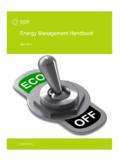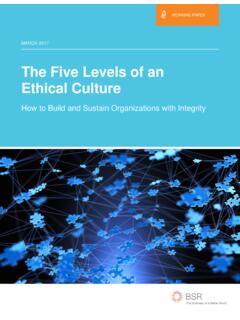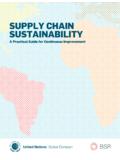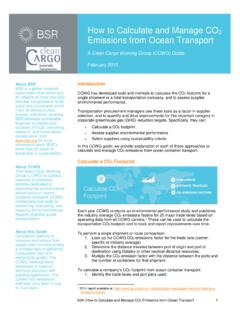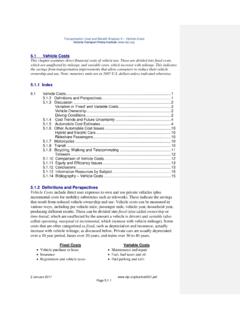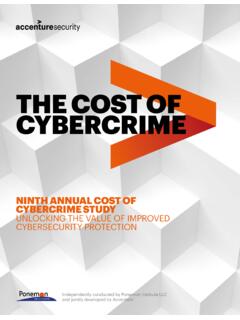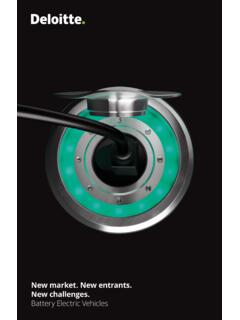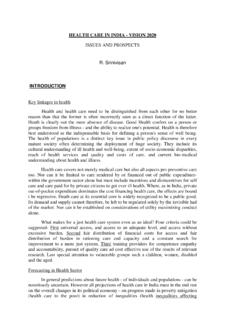Transcription of Adapting to Climate Change: A Guide for the Mining ... - BSR
1 BSR | Adapting to Climate change : A Guide for the Mining Industry 1 This primer on Climate change adaptation summarizes how companies in the Mining industry are reporting on Climate change risks and opportunities, and highlights current and emerging best practices and guidance for E&U companies on how to develop a proactive approach to Climate change adaptation. In this brief, Mining refers to companies involved in the extraction of a broad range of metals and minerals, including precious metals, base metals, industrial minerals, coal, and uranium. Introduction Due to the wide geographic distribution of Mining operations, Climate change , including temperature and precipitation shifts as well as more frequent and severe extreme weather events, will have complex impacts on the sector. Climactic conditions will affect the stability and effectiveness of infrastructure and equipment, environmental protection and site closure practices, and the availability of transportation routes.
2 Climate change may also impact the stability and cost of water and energy supplies. Some examples: Warming temperatures will increase water scarcity in some locations, inhibiting water-dependent operations, complicating site rehabilitation and bringing companies into direct conflict with communities for water resources. In arctic and subarctic regions, however, warmer temperatures will open new mineral-rich areas for exploration and will reduce heating costs. The sector s high rate of energy consumption and international trade of products will increase Mining s potential for greenhouse gas emission and energy regulation. Mining companies often operate in some of the most politically and socially challenging parts of the world, where the industry remains an important driver of economic growth. Therefore, threats to the sector s profitability and viability, such as Climate change , may have significant consequences for development in host countries. The extent to which Mining avoids undermining host communities resilience to Climate change , and even fortifies that resilience, will directly impact the industry s reputation, social license to operate, and access to project financing.
3 The Mining industry should take a proactive approach to Climate adaptation for the following reasons: The supply of critical inputs to Mining processes, such as water and energy, is likely to face greater constraints. Employee health and safety will be put at risk by increases in communicable diseases, exposure to heat-related illnesses and the likelihood of accidents related to rising temperatures. Obtaining and maintaining a social license to operate will become more difficult in communities in which Climate change exacerbates existing Adapting to Climate change : A Guide for the Mining Industry Julia Nelson, Manager, Advisory Services Ryan Schuchard, Manager, Climate and Energy This Guide is part of a BSR industry series. For additional Climate adaptation briefs, please visit Contents and Methodology This brief covers: Reporting on Risks and Opportunities: A synopsis based on reporting of Climate risk in 2009 by 41 Mining companies to the Carbon Disclosure Project (CDP).
4 Current Practices: An outline of actions related to Climate change adaptation based on reporting from the CDP, interviews, and other publications. Emerging Practices: Synthesis of company disclosures, literature, reviews, and input from Climate change professionals through interviews. BSR | Adapting to Climate change : A Guide for the Mining Industry 2 vulnerabilities and increases direct competition between the company and the community for resources. Increased physical and nonphysical risks will make project financing more difficult to secure. This brief examines how Climate change is affecting the Mining industry and how companies are responding. While Mining companies have primarily focused on Climate change mitigation, they are starting to take significant steps to adapt to the consequences of Climate change . Leading companies are developing sophisticated and integrated Climate adaptation strategies that take a comprehensive approach to helping their organizations manage risk and seize opportunity.
5 However, there is still considerable opportunity to embed management of Climate change impacts across the industry, and to collaborate with stakeholders to do so in an efficient and effective manner. Reporting on Risks and Opportunities The following is an analysis of the 2009 Mining company disclosures of Climate change risks and opportunities to the Carbon Disclosure Project (CDP), one of the largest repositories of company reporting on Climate Our review of company responses revealed common themes in reported risks and opportunities, which are grouped and summarized in the six areas below, and accompanied by examples of companies that provided those responses. The companies that publicly reported on Climate change risks and opportunities included a mix of major multinational and mid-tier Mining companies, though it should be noted that some significant actors have yet to participate publicly. Note that company names provided as examples do not constitute a comprehensive list of all companies that gave similar responses.
6 1. DISTURBANCE TO MINE INFRASTRUCTURE AND OPERATIONS Natural disasters, changes to precipitation patterns, and rising sea levels may damage infrastructure, requiring additional measures to ensure its stability. Existing assets may no longer be able to meet original design parameters, and resource scarcity may constrain operations or increase costs. Impacts Companies More frequent and intense natural disasters may damage mine, transportation, and energy infrastructure and equipment, which in turn will disrupt construction and operations. Heavy rain and increased erosion may affect slope stability near opencast mines, and rising sea level may make coastal facilities harder to access. Alumina, Anglo American, Barrick, China Steel, Kumba Iron Ore, Mitsubishi Materials Corp., Rio Tinto Group, Teck, Xstrata, Yamana Gold Hotter and drier conditions may increase wildfires that threaten facilities. Anglo Platinum, Cameco, Gold Fields Flooding from increased rainfall in some areas can interrupt production, and may necessitate additional controls to enhance water treatment capacity.
7 AngloGold Ashanti, Exxaro, Harmony Gold Mining , Limerick Alumina Refining, Newmont Mining Reduced amounts of water may be available for Mining , processing, and refining activities. Costs will increase for pre-use and post-use water treatment. Barrick, China Steel, Teck, Xstrata, Anglo Platinum 1 For more information on the Carbon Disclosure Project, see Carbon Disclosure Project Highlight: Of 41 company disclosures in 2009, 76 percent responded that Climate change represents physical risk to the company, and 46 percent responded that physical impacts of Climate change present opportunity. Source: BSR Analysis Of all of the 2009 public CDP respondents, South African companies are particularly active in discussing Climate change risks and opportunities, because many have started to feel the consequences of Climate - change -related legislation, as well as energy and water scarcity. Mining (and other) companies need to openly discuss, share information, and communicate about adaptation regularly.
8 Companies should share costs and otherwise support Climate modeling and other scientific and technical studies necessary to develop adaptation strategies when they are operating in the same region. Vivian MacKnight, Sustainable Development Analyst, Vale Key: Risks Opportunities BSR | Adapting to Climate change : A Guide for the Mining Industry 3 rising temperatures will increase energy demand to cool underground mines and surface facilities. Greater demand and rising prices (driven by limited supply of natural gas, the imposition of carbon taxes, and expensive alternative energy sources) will add to costs. Anglo Platinum, Mitsubishi Materials Corp., Northam Platinum, Outokumpu, Mining Simms Temperature fluctuations that increase energy demand and strain the capacity of transmission and distribution facilities can disrupt supply to operations. Energy rationing may lead to permanent decreases in production, affecting profits and commodity prices. Aquarius Platinum, Barrick, China Steel, Gold Fields, Harmony Gold Mining , Implats, Kinross Warming ambient temperatures in the Arctic and other cold climates will make it easier to operate and reduce heating costs.
9 Agnico-Eagle Mines, Cameco, Kinross, Teck 2. CHANGING ACCESS TO SUPPLY CHAINS AND DISTRIBUTION ROUTES Increasing temperatures, greater precipitation, shifting storm patterns, and rising sea level will enable or inhibit transportation services that supply goods and services, carry personnel, and move ore to facilities for processing and to ports for export. Impacts Companies Natural disasters and heavy rainfall are likely to disrupt land transportation routes and degrade roads. Disruption in delivery of input materials such as steel, timber, cement, hydrochloric acid, and cyanide, or consumables such as diesel, tires, and reagents, will curtail production or limit its efficiency. Exxaro, Gold Fields, Goldcorp, Kumba Iron Ore, Sesa Goa, Implats, Xstrata, Vale Permafrost thaw on winter ice roads will interfere with consistent and timely supply of critical materials, potentially halting production at sites in the Arctic. The time available for haulage on ice roads will be shorter.
10 Kinross, Rio Tinto Group Sea-level rise and frequent storms may affect port availability, interfering with timely transport to market. Demand for rail and road networks as alternative transportation mediums will rise, increasing costs. Anglo American, Exxaro, Rio Tinto Group, Sterlite Gold, Vale rising temperatures will keep northern sea channels free of ice, allowing longer and more efficient shipping seasons for operations in arctic regions. Teck 3. CHALLENGES TO WORKER HEALTH AND SAFETY CONDITIONS Natural disasters pose immediate health and safety risks, while warmer temperatures may affect worker recruitment, retention, safety, and productivity by increasing risks of accidents, creating or exacerbating food and water shortages, and causing greater prevalence of disease. Impacts Companies rising temperatures increase the risk of heat-related illnesses and inhibit decision-making, increasing the likelihood of injuries, accidents, and fatalities and decreasing productivity.
